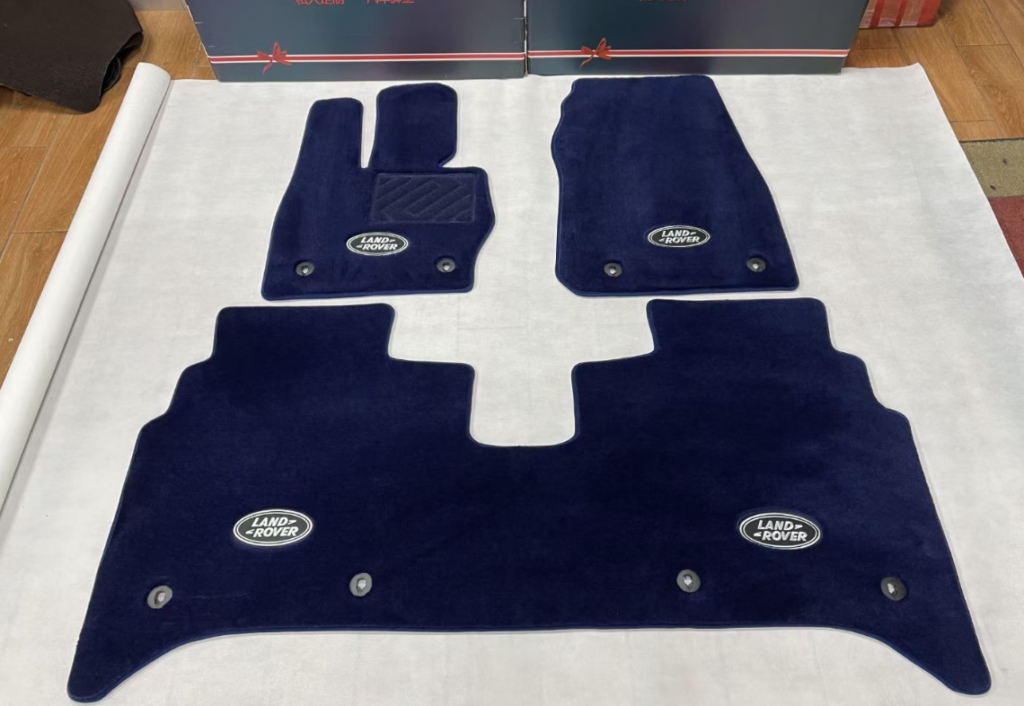Car carpet floor mats are an integral part of car interior decoration, but in daily use, they often face problems such as mud stains, dirt, and odors. To keep your floor mats clean, durable and comfortable, proper cleaning methods are crucial. Floor mats made of different materials have different methods of dealing with stains, regular cleaning steps, selection of cleaning supplies, etc. I hope the following content can help you easily solve your questions about floor mat cleaning.
First. Foot pads of different materials
Before you start cleaning, it’s important to understand the properties of different floor mat materials. Rubber, nylon, wool and other materials all have their own advantages, but they also have different cleaning requirements. Rubber mats are generally more wear-resistant and suitable for waterproof cleaning; nylon mats are soft and easy to clean, but you need to be careful to avoid using too strong detergents; wool mats provide extra warmth in winter, but you need to be more careful when cleaning.
Second. Daily maintenance and regular cleaning
Proper daily maintenance and regular cleaning can extend the life of your floor mats. I will share some simple and easy daily maintenance tips, such as timely cleaning of dust, preventing stains from penetrating, and the steps and methods of regular deep cleaning.
Routine maintenance is the first step in keeping your floor mats clean. Regular cleaning can deeply remove difficult-to-remove stains and extend the service life of the mats. In terms of daily maintenance, regular use of a vacuum cleaner to remove dust and wiping the surface with a damp cloth are key steps. When cleaning regularly, you can take out the foot pads and wash and dry them thoroughly to ensure that every corner is fully cleaned.
Third. Selection of car floor mat cleaning supplies
Choosing the right cleaning products is key to keeping your floor mats clean. A vacuum cleaner is a powerful assistant for daily cleaning, and the choice of cleaner depends on the material of the mats and the actual stains. In addition, brushes, wet cloths, towels and other tools are also commonly used cleaning aids. Knowing how to properly select and use these cleaning products can improve cleaning results while protecting the texture of your mats.
1. Vacuum cleaner:
Adjust the vacuum cleaner to the appropriate power, vacuum horizontally and vertically, and ensure that the vacuum cleaner head can cover the entire surface of the mat.
2. Cleaning agent:
How to use: Dilute the detergent according to the instructions, apply to the stained area, and wipe with a damp cloth. For overall cleaning, dilute the detergent in a cleaning bucket, apply it to the surface of the mat with a brush, and then wipe clean with a damp cloth.
3. Brush and damp cloth:
How to use: Apply the cleaner to the stained area, brush lightly with a brush, and then wipe with a damp cloth. For general cleaning, dampen a cloth with detergent and wipe the entire mat surface.
4. Towels:
Instructions for use: After wiping with a damp cloth, wipe it twice with a towel to ensure that the surface of the mat is completely dry.
5. Cleaning spray:
How to use: Spray the cleaning spray evenly on the surface of the mat and wait for it to dry.
Fourth. Tips for cleaning stains
Different stains require different cleaning techniques. Whether it’s oil stains, drink stains or mud, this chapter will provide you with detailed cleaning methods for each stain, ensuring that you can deal with all types of stains quickly and effectively.
1. Oil stains: Soak in oil-absorbing paper or detergent and wipe gently. Avoid using too strong cleaning agents to prevent damage to the surface of the mats.
2. Beverage stains: Quickly absorb excess liquid with a damp cloth, then wipe with detergent. For deep stains, use diluted white vinegar or an alkaline cleaner.
3. Mud: After the mud stains are dry, use a brush to remove the mud stains, and then wipe with a damp cloth. If there is any residue, use detergent to clean it.
4. Odor treatment: Ventilation is the simplest method of odor treatment. For stubborn odors, use a professional car interior cleaner or place a deodorizing bag in the car.
5. Special stains (such as paint, glue, etc.): Use the corresponding detergent or solvent and clean according to the product instructions. For special stains, you can first use oil-absorbing paper to absorb excess material, and then treat it with detergent.
Fifth. Odor treatment and elimination
Floor mats may develop odor due to moisture or prolonged use. Solving odor problems requires a deep understanding of the cause of the odor. This chapter will introduce some common odor treatment methods, such as regular ventilation, use of deodorants, lighting, etc., to help drivers easily eliminate odors and keep the air in the car fresh.
1. Ventilation: Fully ventilate the vehicle and open the windows to allow fresh air to flow into the vehicle. Especially when the weather is nice and the temperature is moderate, a few hours of ventilation can significantly reduce odors.
2. Use deodorizer: Place professional car interior deodorizer. These products can usually absorb odor molecules and improve the air inside the car. Choose non-toxic, non-irritating products to ensure safe use.
3. Light disinfection: On a sunny day, take out the foot pads and expose them to the sun. Sunlight has a sterilizing and disinfecting effect, which can effectively reduce odor and remove potential bacteria.
4. Carbon bag adsorption: Use activated carbon or bamboo charcoal bags. These natural adsorbents can absorb moisture and odors. Leave it in the car regularly to avoid having the vehicle closed for long periods of time.
5. Dehumidifier: For odor caused by moisture, using a car dehumidifier is an effective method. These products absorb excess moisture in your car and reduce odors.
6. Clean the air conditioning system: Your car’s air conditioning system can be a source of odors. Regularly cleaning the air conditioning system and replacing the air conditioning filter can effectively reduce the generation of odors.
7. Replace the floor mats: If the odor cannot be resolved by the above methods, consider replacing the floor mats. Choose new floor mats that are easy to clean and antibacterial to ensure fresh air in your car.
8. Vinegar deodorization method: Place white vinegar in the car. The acidic component of the vinegar can neutralize the odor. However, pay attention to the concentration when using it and avoid the strong vinegar smell.
9. Aromatherapy and odor elimination method: Use car-specific aromatherapy products to cover up odors through aroma molecules. Choose a subtle scent and avoid pungent smells.
10. Charcoal bag odor absorption method: Place activated carbon bags or bamboo charcoal bags in the car. These odor absorbers can absorb odor molecules and purify the air.
Sixth: Protective measures
Finally, I will introduce some protective measures, such as using waterproof spray, regularly applying maintenance agents, etc., to help you reduce the possibility of damage to your foot pads in daily use and extend their service life.
1. Use waterproof spray: Use waterproof spray regularly to protect the foot pads. This spray can form a protective film to prevent liquid from penetrating into the mat, effectively preventing odor and corrosion caused by moisture.
2. Apply maintenance agent regularly: Choose a maintenance agent suitable for the material of the foot pads and apply it regularly on the surface of the foot pads. This helps maintain the softness and gloss of the mat and slows down the aging process of the material.
3. Use floor mat spacers: Cover the surface of the floor mats with a layer of floor mat spacers, similar to seat covers. This can reduce the direct pressure on the foot pads, delay wear and tear, and facilitate cleaning and replacement.
4. Clean the bottom of the mats regularly: Turn over the mats regularly and clean the bottom of the mats. This helps prevent dirt from remaining on the bottom for a long time and slows down the aging process of the mats.
5. Avoid sharp objects: Avoid carrying sharp objects in the car to avoid scratching or tearing the floor mats when stepping on them.
6. Check the fixing system regularly: If the vehicle is equipped with a fixing system (such as buckles or anti-slip design on the bottom of the rubber pad), check regularly whether it is intact. Make sure the foot pads remain stable during use.
7. Avoid excessive exposure to the sun and high temperatures: Avoid parking the vehicle in direct sunlight for a long time to slow down the color fading and material aging of the mats.
8. Deal with stains in time: When the mats are stained, treat them promptly to prevent the stains from penetrating and damaging the material of the mats for a long time.
9. Choose high-quality floor mats: When purchasing floor mats, choose high-quality products that are wear-resistant, antibacterial, and waterproof, and can better resist damage from the external environment.
By mastering the cleaning tips provided in this article, I hope you will be able to easily solve various stain problems and provide a pleasant driving environment for drivers and passengers.


